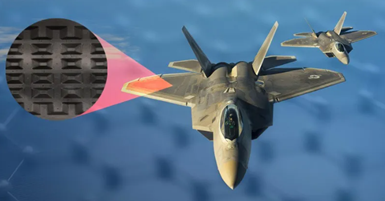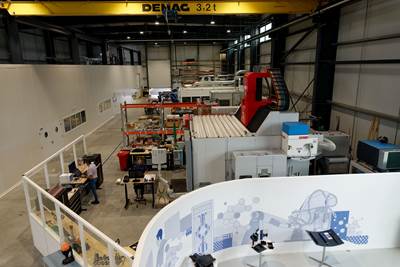UD researchers advance TuFF composite's viability for aerospace
The University of Delaware’s research team continues to mature the short fiber composite’s cost competitiveness with metal through sensor embedding, virtual modeling and TuFF thermoset manufacture.
Share

Photo Credit: University of Delaware
TuFF — tailored universal feedstock for forming — is a strong, highly aligned, short-fiber composite material that can be made from many fiber and resin combinations. Created at the University of Delaware’s Center for Composite Materials (UD-CCM, Newark, U.S.), it can be stamped into complex shapes, just like sheet metal, and features high-performance and stretchability up to 40%.
Since its introduction, CCM researchers have explored applications for TuFF, from materials for repairing U.S. pipelines to uses in flying taxis of the future (see “…TuFF composite material shows high potential for UAM” and “UD’s Center for Composite Materials hosts NASA University Leadership Initiative”). Now, armed with $13.5 million in funding from the U.S. Air Force, UD mechanical engineers and co-principal investigators Suresh Advani and Erik Thostenson, along with industry collaborators Composites Automation (Cape Coral, Fla., U.S.) and Maher and Associates (Baltimore, Md., U.S.) are working on ways to improve manufacturing methods for TuFF.
“I am excited at the opportunity to mature the TuFF prepregging process and demonstrate high-throughput composite thermoforming for Air Force-relevant components,” David Simone of the U.S. Air Force says.
The ultimate goal is to enable composites to be become cost-competitive with aluminum for creating small parts found in air vehicles. Advani, George W. Laird professor of mechanical engineering, explains that when it comes to making aircraft materials more cost-efficient, reducing a material’s weight even a mere kilogram, just 2.2. pounds, will reduce fuel consumption and emissions and can result in thousands of dollars in savings over time.
“In general, the aerospace industry wants to reduce weight and replace metals,” Advani says. “TuFF is a good option because the material can achieve properties equivalent to the best continuous fiber composites used in aerospace applications.”
Advancing TuFF thermosets
Until now, most of the work around TuFF has focused on thermoplastic composite materials that melt when heated, becoming soft and pliable, which is useful for forming. By contrast, TuFF thermosets have a higher temperature threshold, making them useful for aerospace applications. But TuFF thermosets have manufacturing challenges, too, according to researchers, including the long manufacturing times necessary to make a part.
In this new project, Thostenson and Advani will work on ways to improve the viability of thermoset TuFF composites. To start, the researchers will characterize the starting materials’ mechanical properties to understand how to make TuFF thermosets reliably and consistently. The research team will explore whether they can make the material in a new way, using thin resin films and liquid resins. They will also test the limits of how the material forms and behaves under pressure and temperature.
“I am hoping this work will allow us finally to make composites cost competitive with the metal industry.”
“How does it stretch during forming in a mold? What shapes can we make? When does it tear or thin or develop voids that can compromise material integrity?” Advani asks. He believes that having a database for such properties and behaviors will be useful in understanding TuFF material capabilities and limits, and to inform efforts to model and design parts with TuFF.
Thostenson, professor of mechanical engineering, and an expert in structural health monitoring (SHM) of materials, is advancing ways to embed sensor technology into TuFF thermosets so as to better gauge — and improve — the material’s damage tolerance. A single layer of TuFF material is approximately 100 microns thick, about the diameter of the average human hair. The carbon-nanotube sensors Thostenson plans to integrate into the material are smaller still — one billionth the width of a human hair.
“This would allow us to do health monitoring for the materials and parts during service life, but you could also imagine using sensor technology to detect a defect during manufacturing,” Thostenson says.
The research team also plans to develop a virtual modeling system to refine the material-forming process through computer simulation instead of by trial and error. In this way, the team will better understand each step in the material-forming process, enhancing the team’s ability to make TuFF materials consistently and reliably — a must for aerospace applications.
“I am hoping this work will allow us finally to make composites cost competitive with the metal industry,” Advani adds.
In addition to Thostenson and Advani, the team includes, from CCM, Jack Gillespie, Dirk Heider, Shridhar Yarlagadda, Thomas Cender, John Tierney and Pavel Simacek, along with four to five graduate students.
Related Content
IMT Nord Europe launches COMPOLIS initiative
COMPOLIS is an R&I hub bringing together industrial partners, dedicated to connected materials and structures with the ultimate goal of digitalizing composite materials.
Read MoreUniversity of Southampton develops miniaturized optical fiber condition monitoring technology
A more compact, affordable strain interrogator, currently developed for FBG monitoring, may enable more widespread adoption of optical fiber sensing used in composite materials.
Read MoreMiniLab consortium produces first full-scale thermoplastic composite hydrofoils
Project advances toward first recyclable foils for ocean racing, part of “Infinite Foil” finalist for JEC Innovation Award 2025.
Read MoreHBK enhances sensor offerings with MicroStrain acquisition
MicroStrain designs and manufactures high-precision inertial and wireless sensing systems that cater to industries such as automation, mobility and unmanned vehicles.
Read MoreRead Next
Assembling the Multifunctional Fuselage Demonstrator: The final welds
Building the all-thermoplastic composite fuselage demonstrator comes to an end with continuous ultrasonic welding of the RH longitudinal fuselage joint and resistance welding for coupling of the fuselage frames across the upper and lower halves.
Read MorePlant tour: Daher Shap’in TechCenter and composites production plant, Saint-Aignan-de-Grandlieu, France
Co-located R&D and production advance OOA thermosets, thermoplastics, welding, recycling and digital technologies for faster processing and certification of lighter, more sustainable composites.
Read MoreAll-recycled, needle-punched nonwoven CFRP slashes carbon footprint of Formula 2 seat
Dallara and Tenowo collaborate to produce a race-ready Formula 2 seat using recycled carbon fiber, reducing CO2 emissions by 97.5% compared to virgin materials.
Read More


























